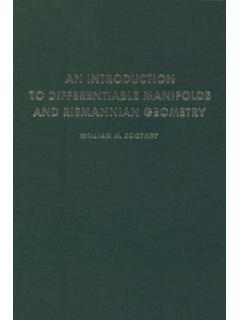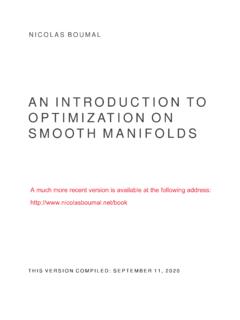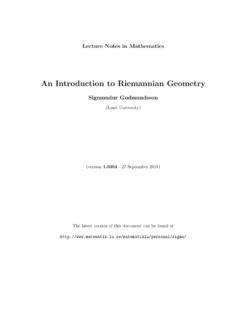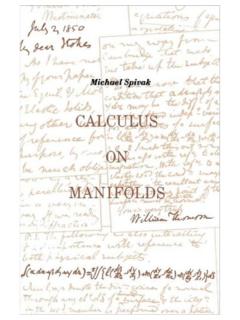Transcription of Introduction to Differential Geometry General Relativity
1 Introduction to Differential Geometry & General Relativity 6th Printing May 2014 Lecture Notes by Stefan Waner with a Special Guest Lecture by Gregory C. Levine Departments of Mathematics and Physics, Hofstra University 2 Introduction to Differential Geometry and General Relativity Lecture Notes by Stefan Waner, with a Special Guest Lecture by Gregory C. Levine Department of Mathematics, Hofstra University These notes are dedicated to the memory of Hanno Rund. TABLE OF CONTENTS 1. Preliminaries ..3 2. Smooth Manifolds and Scalar Fields ..8 3. Tangent Vectors and the Tangent Space ..16 4. Contravariant and Covariant Vector Fields ..26 5. Tensor Fields ..37 6. Riemannian Manifolds ..42 7. Locally Minkowskian Manifolds: An Introduction to Relativity ..52 8. Covariant Differentiation ..63 9. Geodesics and Local Inertial Frames ..71 10. The Riemann Curvature Tensor ..83 11. A Little More Relativity : Comoving Frames and Proper Time.
2 94 12. The Stress Tensor and the Relativistic Stress-Energy Tensor ..100 13. Two Basic Premises of General Relativity ..109 14. The Einstein Field Equations and Derivation of Newton's Law ..114 15. The Schwarzschild Metric and Event Horizons ..124 16. White Dwarfs, Neutron Stars and Black Holes, by Gregory C. Levine .131 References and Further Reading ..138 The author is grateful to Daniel Metz (an appreciative reader) for his corrections that appear in the latest version, and to many of my students who uncovered errors and inconsistencies in previous versions. 3 1. Preliminaries Distance and Open Sets Here, we do just enough topology so as to be able to talk about smooth manifolds. We begin with n-dimensional Euclidean space En = {(y1, y2, .. , yn) | yi R}. Thus, E1 is just the real line, E2 is the Euclidean plane, and E3 is 3-dimensional Euclidean space. The magnitude, or norm, ||y|| of y = (y1, y2.)
3 , yn) in En is defined to be ||y|| = y12 + y22 + .. + yn2 , which we think of as its distance from the origin. Thus, the distance between two points y = (y1, y2, .. , yn) and z = (z1, z2, .. , zn) in En is defined as the norm of z - y: Distance Formula Distance between y and z = ||z - y|| = (z1 - y1)2 + (z2 - y2)2 + .. + (zn - yn)2 . Proposition (Properties of the norm) The norm satisfies the following: (a) ||y|| 0, and ||y|| = 0 iff y = 0 (positive definite) (b) || y|| = | |||y|| for every R and y En. (c) ||y + z|| ||y|| + ||z|| for every y, z En (triangle inequality 1) (d) ||y - z|| ||y - w|| + ||w - z|| for every y, z, w En (triangle inequality 2) The proof of Proposition is an exercise which may require reference to a linear algebra text (see inner products ). Definition A Subset U of En is called open if, for every y in U, all points of En within some positive distance r of y are also in U.
4 (The size of r may depend on the point y chosen. Illustration in class). Intuitively, an open set is a solid region minus its boundary. If we include the boundary, we get a closed set, which formally is defined as the complement of an open set. Examples (a) If a En, then the open ball with center a and radius r is the subset B(a, r) = {x En | ||x-a|| < r}. 4 Open balls are open sets: If x B(a, r), then, with s = r - ||x-a||, one has B(x, s) B(a, r). (b) En is open. (c) is open. (d) Unions of open sets are open. (e) Open sets are unions of open balls. (Proof in class) Definition Now let M Es. A subset V M is called open in M (or relatively open) if, for every y in V, all points of M within some positive distance r of y are also in V. Examples (a) Open balls in M If M Es, m M, and r > 0, define BM(m, r) = {x M | ||x-m|| < r}. Then BM(m, r) = B(m, r) M, and so BM(m, r) is open in M.
5 (b) M is open in M. (c) is open in M. (d) Unions of open sets in M are open in M. (e) Open sets in M are unions of open balls in M. Parametric Paths and Surfaces in E3 and in Es From now on, the three coordinates of s-space will be referred to as y1, y2, .. , ys. Definition A smooth path in E3 is a set of three smooth (infinitely differentiable) real-valued functions of a single real variable t: y1 = y1(t), y2 = y2(t), y3 = y3(t). The variable t is called the parameter of the curve. The path is non-singular if the vector (dy1dt ,dy2dt ,dy3dt ) is nowhere zero. Notes (a) Instead of writing y1 = y1(t), y2 = y2(t), y3 = y3(t), we shall simply write yi = yi(t). 5 (b) Since there is nothing special about three dimensions, we define a smooth path in En in exactly the same way: as a collection of smooth functions yi = yi(t), where this time i goes from 1 to n. Examples (a) Straight lines in E3 (b) Curves in E3 (circles, etc.)
6 Definition A smooth surface embedded in E3 is a collection of three smooth real-valued functions of two variables x1 and x2 (notice that x finally makes a debut). y1 = y1(x1, x2) y2 = y2(x1, x2) y3 = y3(x1, x2), or just yi = yi(x1, x2) (i = 1, 2, 3). with domain some open set D in E2. We also require that: (a) The 3 2 matrix whose ij entry is yi xj has rank two. (This is a local property which says that the functions yi define an immersion.) (b) The associated function D E3 is a one-to-one map (that is, distinct points (x1, x2) in parameter space E2 give different points (y1, y2, y3) in E3). (This is a global property which says that the functions yi define an enbedding.) We call x1 and x2 the parameters or local coordinates. Examples (a) Planes in E3 and in Es (b) The paraboloid y3 = y12 + y22 (c) The sphere y12 + y22 + y32 = 1, using spherical polar coordinates: y1 = sin x1 cos x2 y2 = sin x1 sin x2 y3 = cos x1 where 0 < x1 < and 0 < x2 < 2.
7 Note that we cannot allow x1 = 0 or in the domain, or else conditions (a) and (b) would both fail there, nor can we allow x2 = 0 and 2 because conditions (b) would fail at x2 = 0 and 2 , so we restrict that domain to {(x1, 6 x2) 0 < x1 < and 0 < x2 < 2 } in order to meet both conditions , meaning that we get only the portion of the sphere excluding the equator and international date line. (d) The ellipsoid y12a2 + y22b2 + y32c2 = 1, where a, b and c are positive constants. (e) We calculate the rank of the Jacobean matrix for spherical polar coordinates. (f) The torus with radii a > b: y1 = (a+b cos x2)cos x1 y2 = (a+b cos x2)sin x1 y3 = b sin x2 (Note that if a b this torus is not embedded.) (g) The functions y1 = x1 + x2 y2 = x1 + x2 y3 = x1 + x2 specify the line y1 = y2 = y3 rather than a surface. Note that conditions (a) and (b) fail terribly (h) The cone y1 = x1 y2 = x2 y3 = (x1)2 + (x2)2 fails to be smooth at the origin (partial derivatives do not exist at the origin).
8 Question The parametric equations of a surface show us how to obtain a point on the surface once we know the two local coordinates (parameters). In other words, we have specified a function from a subset of E2 to E3. How do we obtain the local coordinates from the Cartesian coordinates y1, y2, y3? Answer We need to solve for the local coordinates xi as functions of yj. This we do in one or two examples in class. For instance, in the case of a sphere, we get, for points other than (0, 0, 1): x1 = cos-1(y3) x2 = cos-1(y1 / y12+y22 )if y2 02 - cos-1(y1 / y12+y22 )if y2 < 0 . (Note that x2 is not defined at (0, 0, 1).) This allows us to give each point on much of the sphere two unique coordinates, x1, and x2. There is a problem with continuity when y2 = 0 and y1 > 0, since then x2 switches from 0 to 2 . Thus, we restrict to the portion of the sphere given by 0 < x1 < (North and South poles excluded) 7 0 < x2 < 2 (International date line excluded) which is an open subset U of the sphere.
9 We call x1 and x2 the coordinate functions. They are functions x1: U E1 and x2: U E1. We can put them together to obtain a single function x: U E2 given by x(y1, y2, y3) = (x1(y1, y2, y3), x2(y1, y2, y3)) = cos-1(y3), cos-1(y1 / y12+y22 )if y2 02 - cos-1(y1 / y12+y22 )if y2 < 0 as specified by the above formulas, as a chart. Definition A chart of a surface S is a pair of functions x = (x1(y1, y2, y3), x2(y1, y2, y3)) which specify each of the local coordinates (parameters) x1 and x2 as smooth functions of a General point (global or ambient coordinates) (y1, y2, y3) on the surface. Question Why are these functions called a chart? Answer The chart above assigns to each point on the sphere (away from the meridian) two coordinates. So, we can think of it as giving a two-dimensional map of the surface of the sphere, just like a geographic chart.
10 8 Question Our chart for the sphere is very nice, but is only appears to chart a portion of the sphere. What about the missing meridian? Answer We can use another chart to get those by using different paramaterization that places the poles on the equator. (Diagram in class.) In General , we chart an entire manifold M by covering it with open sets U which become the domains of coordinate charts. Exercise Set 1 1. Prove Proposition (Consult a linear algebra text.) 2. Prove the claim in Example (d). 3. Prove that finite intersection of open sets in En are open. 4. Parametrize the following curves in E3. (a) a circle with center (1, 2, 3) and radius 4 (b) the curve x = y2; z = 3 (c) the intersection of the planes 3x-3y+z=0 and 4x+y+z=1. 5. Express the following planes parametrically: (a) y1 + y2 - 2y3 = 0. (b) 2y1 + y2 - y3 = 12. 6. Express the following quadratic surfaces parametrically: [Hint.]









